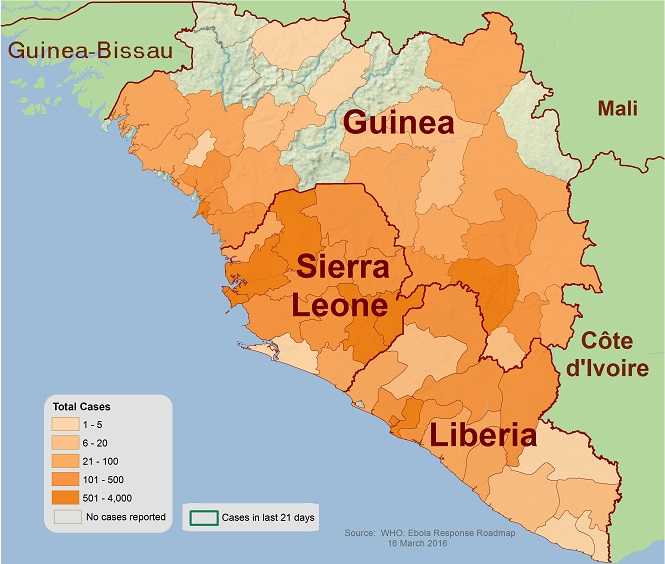2014 Ebola Outbreak in West Africa - Case Counts
Case Counts
Case counts are updated in conjunction with the World Health Organization updates and are based on information reported by the ministries of health. For detailed information on reported cases of Ebola in the United States, see Cases of Ebola Diagnosed in the U.S..
As of April 13, 2016
(Updated April 13, 2016)
Countries with Former Widespread Transmission and Current, Established Control Measures1
| Country | Total Cases (Suspected, Probable, and Confirmed) | Laboratory-Confirmed Cases | Total Deaths |
|---|---|---|---|
| Guinea 2 | 3814 | 3358 | 2544 |
| Sierra Leone 3 | 14124 | 8706 | 3956 |
| Liberia4 | 10678 | 3163 | 4810 |
| Total | 28616 | 15227 | 11310 |
Previously Affected Countries5
| Country | Total Cases (Suspected, Probable, and Confirmed) | Laboratory-Confirmed Cases | Total Deaths |
|---|---|---|---|
| Nigeria | 20 | 19 | 8 |
| Senegal | 1 | 1 | 0 |
| Spain | 1 | 1 | 0 |
| United States | 4 | 4 | 1 |
| Mali | 8 | 7 | 6 |
| United Kingdom | 1 | 1 | 0 |
| Italy | 1 | 1 | 0 |
| Total | 36 | 34 | 15 |
1 This category also includes countries that have experienced widespread transmission but are transitioning to being declared free of Ebola virus transmission. The World Health Organization (WHO) is responsible for determining when a country will be declared free of Ebola virus transmission. Public health authorities in these countries should maintain active surveillance for new cases of Ebola and identify, locate, and monitor any potential contacts.
2 On December 29, 2015, WHO declared Guinea free of Ebola virus transmission after 42 days (two incubation periods) had passed since the last Ebola patient tested negative. On December 29, 2015, CDC changed the country classification for Guinea to a country with former widespread transmission and current, established control measures.
3 On November 7, 2015, WHO declared Sierra Leone free of Ebola virus transmission after 42 days (two incubation periods) had passed since the last Ebola patient tested negative. On November 10, 2015, CDC changed the country classification for Sierra Leone to a country with former widespread transmission and current, established control measures. Two new confirmed cases were reported in January 2016. On March 17, 2016, WHO declared the end of the flare-up after 42 days had passed since the last Ebola patient tested negative.
4 WHO first declared Liberia free of Ebola virus transmission on May 9, 2015. The country subsequently experienced a cluster of six Ebola cases in June 2015 and was declared free of transmission again on September 3, 2015. A second cluster of three cases was reported in November 2015, and WHO declared the country free of transmission for the third time on January 14, 2016.
5 In these countries, which previously had locally acquired or imported Ebola cases, at least 42 days (two incubation periods) have elapsed since the last day that any person in the country had contact with a person with confirmed Ebola.
- Page last reviewed: April 14, 2016
- Page last updated: April 14, 2016
- Content source:




 ShareCompartir
ShareCompartir

